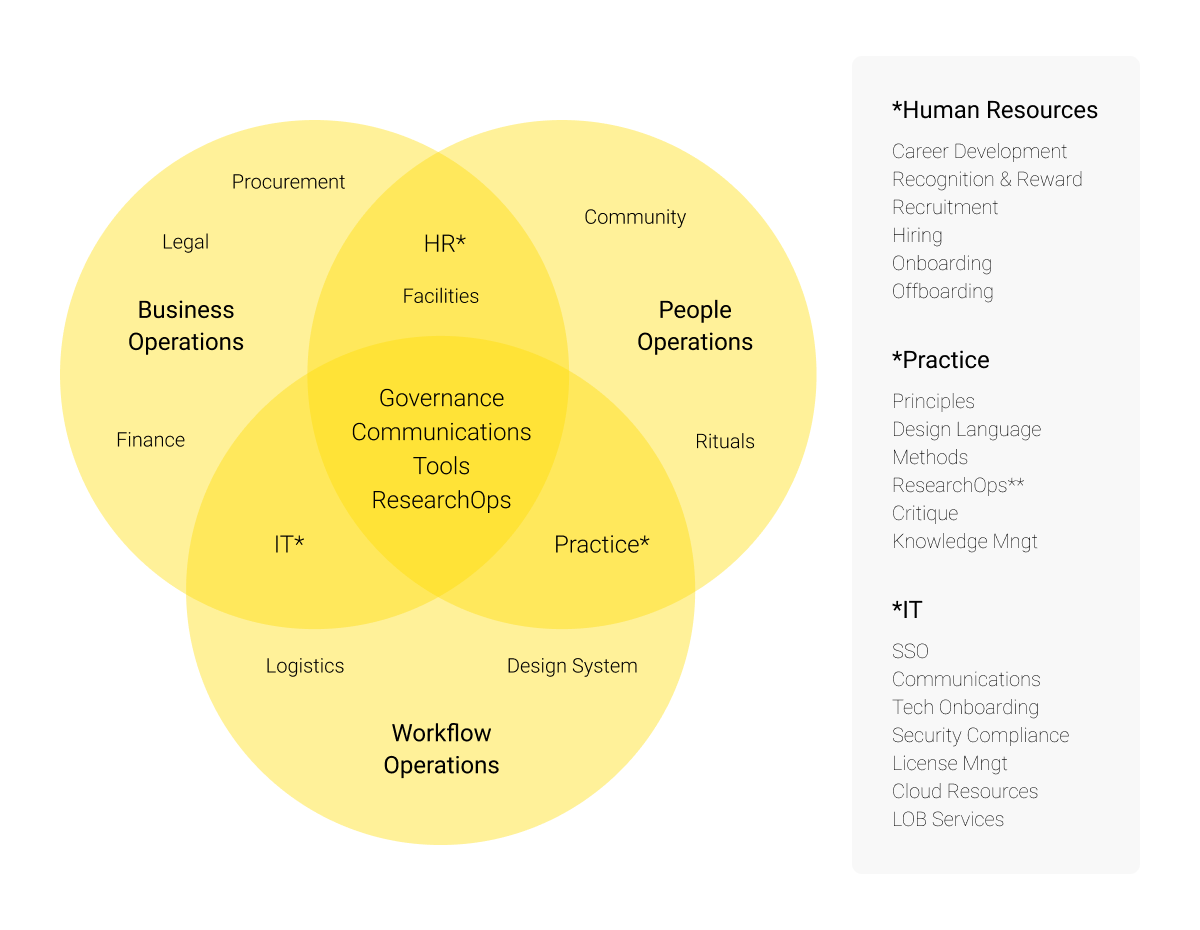- What DesignOps is
- What a DesignOps engineer deals with
- How to figure out whether you need a DesignOps team
- Who is in charge of design operations?
- What problems does DesignOps solve?
- Conclusion
New ideas and trends frequently appear in the design community, and DesignOps is one of them. Let’s figure out what the new approach is, what problems it solves, and whether a company needs a separate DesignOps team.
What DesignOps is
The research by Workfront for 2019 - State of Work Survey - discovered that American employees spend 60% of their workday on tasks that are not associated with their direct responsibilities. During the experiment, long hours were spent on planning meetings, correspondence by mail, and the implementation of other organizational issues.
As a firm grows, designers face the same problem - they have to perform non-design tasks. And here DesignOps comes to the rescue, removing unnecessary responsibilities from them.
DesignOps (Design Operations) is a collective term that refers to the mechanisms for organizing the work of the design department. Сorrespondingly, a DesignOps engineer is the name of a specialist who solves issues related to the growth of the team, the search for employees, the purchase of equipment, the control of design results, and so on. The task of DesignOps engineers is to free designers from such problems so that they can serenely conduct research and create quality products.
Consultant Dave Malouf uses such metaphors as ‘the front of the house’ and ‘the back of the house’ when explaining DesignOps. ‘The front of the house’ refers to the user experience with the product. The Design Manager is responsible for developing products that are highly user-friendly and valuable for the buyer. ‘The back of the house’ refers to the tools and processes that help designers support the creation of an enhanced user experience. But, as Malouf summarizes, DesignOps is everything that supports the high quality of crafts, techniques, and processes.
What a DesignOps engineer deals with
Generally speaking, a DesignOps engineer performs any task that increases the efficiency of the designers' work. This specialist saves the team time so that its members are not distracted by operational issues.
The DesignOps manager is responsible for the following important issues in the team's work:
- Teamwork organization
The DesignOps engineer creates a clear design roadmap that outlines the team's long-term goals and ways to achieve them. The Design Manager becomes the liaison between the UX team members: creating design and activity guides, teaching them tools, prioritizing work, and so on. The Design Manager hires new specialists, trains them, and makes sure they easily adapt and fit into the team.
- Design quality improvement
The DesignOps engineer manages the design process by creating design systems and allocating the necessary tools (for example, a repository to store all files and resources). This specialist organizes and holds design sprints and schedules daily meetings to find out how the design project is going.
- Team culture development
The DesignOps engineer organizes seminars and training for the career development of the design team. In addition, the manager does their best to provide colleagues with professional and emotional support by planning team events.
- Budget allocation and control
Often, the operational designer takes on some monetary issues: calculating how much the maintenance of the design team will cost and advancing arguments for these costs. Once the budget is approved, the DesignOps engineer is responsible for distributing it among employees.

The DesignOps engineer relies on ongoing performance assessments to determine what can be done better to positively impact business indicators. Without a Design Manager, project teams in large organizations are at risk of being divorced from other departments. As a result, processes can overlap, toolkits become cumbersome, and the resulting confusion leads to product non-compliance and discord within the team.
How to figure out whether you need a DesignOps team
In order to understand whether graphic design companies need a DesignOps team, it is necessary to analyze the processes and find out if the problems require the implementation of this practice. For this purpose, the following steps need to be taken:
Step 1. Conduct research
Internal research helps to reveal the main problems of design teams. The data obtained will tell you how specialists evaluate the effectiveness of work processes, what the design gaps are, and what hinders them the most. This information will aid in defining a clear role for the DesignOps engineer.
Step 2. Determine the scope of DesignOps tasks
The research results will help to determine the job responsibilities that the DesignOps engineer will perform - for example, creating a roadmap, planning a design for a product launch, developing an operation scaling plan, and so on. This approach will allow you to see how the DesignOps engineer is able to solve identified problems.
Step 3. Analyze results
In order to ascertain whether the DesignOps practice really works, it is necessary to assess the strides and the impact that the DesignOps specialist makes on the project. If positive results are visible, this new role is justified.
Who is in charge of design operations?
DesignOps presupposes that there is a specialist or a team whose responsibilities include professional support for designers to help them focus on design or research. The responsibilities of the DesignOps engineer in companies are often fulfilled by:
- UX Producers who design at the project level and are involved with design operations.
- UX Program Managers who are tasked with designing at the program or organization level. They work on optimizing global design processes, programs, and tools.
- ResearchOps engineers - specialists who search for and select participants for research, as well as maintain an archive and manage tools, spaces, and equipment.
Not all organizations need a dedicated DesignOps engineer. Designers themselves or senior researchers often carry out the tasks of this specialist in the context of their job responsibilities. However, fast-growing companies with large teams and frequent product releases can benefit from hiring a DesignOps specialist.
What problems does DesignOps solve?
There are several acute issues that can be solved with DesignOps to support designers.
Isolated work
Designers are becoming increasingly isolated from each other when there is no main team or specialists work remotely. This leads to a lack of communication and reduced efficiency. The DesignOps engineer structures teams with a full set of skills, defines the roles of the design department, creates communities where practitioners can share skills and interests, and organizes regular meetings for them.
Lack of time
Operational tasks take up a lot of designers' time: UX specialists conduct email correspondence, participate in meetings, look for research participants, and solve a number of secondary issues. Lack of time and capabilities becomes an obstacle to quality design. DesignOps takes on the operational tasks of organizing a team, hiring new employees, documenting project processes, prioritizing work, evaluating design quality, and so on. The DesignOps engineer takes on the operational tasks of organizing a team, hiring new employees, documenting project processes, prioritizing work, evaluating design quality, and so on.
Shortage of tools
Many project teams don’t have access to all the tools they need. DesignOps helps to improve design quality through consistent toolkits and processes. The expert in this area documents the design process from launch to testing and delivery. This specialist creates data warehouses for user research and applies digital asset manager software (DAMS) or other systems to exchange project assets and templates among team members.
Similar unresolved issues often lead to burnout, slow product implementation, and poor design quality. Any web design agency that implements DesignOps into its processes eliminates these shortcomings, improving design and making its scaling easier.
DesignOps practitioner Patrizia Bertini shared the observation she made in 2018 when working with international teams. The company faced rapid growth, and operational inefficiency caused a slowdown in the working speed and the entire production cycle. Designers spent up to 5 working days a month looking for research participants, and the lead time was lengthened to 4 weeks. This time needed to be shortened. To solve the issue, the DesignOps specialist implemented a participant search service. This solution reduced lead times by 65% and recruiting costs by 60%; the development team saved 430 working days. This case study demonstrates the value of DesignOps in coordinating and addressing the above challenges.
Conclusion
The demand for custom web design is growing, design is becoming more complex, designers are working in isolation from each other more and more often - these are just a few of the design challenges. To cope with them, it is necessary to scale the design without creating obstacles for the employees’ work. This is where DesignOps comes in.
The Design Manager supports designers so that they can create products that add value for their customers and positively impact brand reputation. Expert Kristin Skinner summarizes the role of DesignOps as follows:
“We’re making things better for the team doing the work. In the end it’s about supporting the team and individuals on the team to do their best work.”
Implementation of DesignOps involves not just a structural change but a real cultural shift, as it makes it possible to create a highly integrated and effective team. At Andersen, we employ world-recognized UI/UX design practices to deliver outstanding software solutions. The top-notch quality of our products is highly rated by renowned design communities, such as Awwwards, CSS Design Awards, etc. Contact us to unleash the full potential of your software, equipping it with a seamless interface to meet your end-users’ needs.





